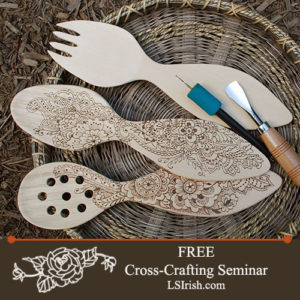Newest Articles by Lora S. Irish
 Wood Carving Spoons Free Tutorial and Projects
Wood Carving Spoons Free Tutorial and Projects
Spoon carving is a wonderful beginning carving project, and a delightful canvas for advanced wood carvers. Every aspect of a wooden spoon can be changed, altered, and decorated.
You will need just a few wood carving chisels and gouges, a bench knife, some sandpaper, and mineral oil to give your spoon a final, food-safe finish.
This large apple butter paddle spoon was carved from 1″ thick basswood. The extra thickness gave more than enough room to add a pottery bird relief carving to the inside of the spoon bowl.
Learn more: Wood Carving Navigation Page
The Art of Spoon Carving by Lora S. Irish
Spoon, Fork, and Ladle Styles for Wood Carving
Wood Carving a Basic Wooden Spoon
Wood Carving Spoons Free Tutorial and Project
Wood Carving Spoons Free Projects
The Art of Spoon Carving by Lora S. Irish

Pyrography & Wood Burning Navigation Page
Fundamentals and Techniques of Pyrography
- The Basic Wood Burning Tool
- Basic Wood Burning Strokes
- Wood Burning Technique Samples
- Step by Step Instructions Project
- Coloring Wood Burned Projects
- Wood Burning Sepia Values
- Wood Burning Animal Fur and Hair
- Mapping Your Pyrography Patterns, Flamingo
- Pyrography Practice Boards for Wood Burning
- Simple Shading in Pyrography, Daisy Pattern
- Tonal Value Sepia Worksheet
Listing of just a few free online tutorials, both here at LSIrish.com and on other forums and message boards.
Free, online seminar links:
Cross-Crafting Seminar Introduction
Cross-Crafting Seminar Supply List
Cross-Crafting Seminar Free Patterns
Cross-Crafting Seminar, Scroll Saw Basics
Cross-Crafting Seminar, Setting Up Your Scroll Saw
Cross-Crafting Seminar, Scroll Sawing the Wood Spirit Face
Cross-Crafting Seminar, Wood Burning the Wood Spirit Face
Cross-Crafting Seminar, Colored Pencils for the Wood Spirit Face
Posted here at LSIrish.com
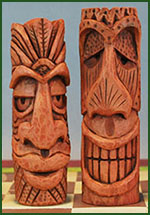 Whittle Tiki Chess Set – Wood Carving
Whittle Tiki Chess Set – Wood Carving
This beginner’s wood carving project will guide you through the cutting strokes that create those wonderfully expressive Tiki faces. Includes the free patterns to make your own chess set.
Basics to Painting – Painting your Wood Carving and Wood Burning
Have fun exploring the numerous techniques you can use to add coloring to your wood burnings, wood carvings, and scroll saw projects.
Postage Stamp Pyrography – Pyrography and wood burning
Have a little fun tonight working through how easy it is to wood burning Celtic interlocking lines and knots.
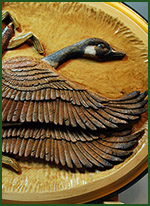 Relief Canada Goose Carving Seminar – Relief wood carving, pyrography, and painting
Relief Canada Goose Carving Seminar – Relief wood carving, pyrography, and painting
Explore the basic techniques used in relief wood carving, including working in layers and levels, undercutting, and smoothing the background. Then add fine detailing using your wood burning tool. Finish this step-by-step project by creating realistic coloring using the dry brushing technique.
Whittle Fish Seminar – Wood carving
Ice fishing decoys are quick, easy, and extremely fun to carve. All you need is a bench knife, a few pieces of basswood, some scrap leather or copper sheeting, and some imagination. Since these are primitive art, anything goes when carving fish decoys.
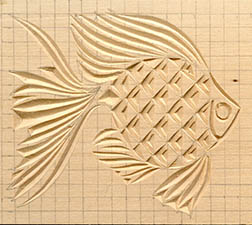 Chip Carving Seminar – Chip Carving, wood carving
Chip Carving Seminar – Chip Carving, wood carving
Chip carving is a specialty area in wood carving. With the use of a short-bladed chip carving knife, small triangular cuts create intrigue motifs and designs. Includes a full-sized sampler pattern.
Celtic Dragon Plaque – Relief wood carving
This is an entry-level carving project for both relief carving and for working the interlocking patterns of the Celtic Knot
Wood Spirit Carving – Wood carving, cane and walking stick carving
Carving a human face into your next walking stick or cane is quite easy when you follow the step-by-step cuts shown in Carving the Planes of the Human Face.
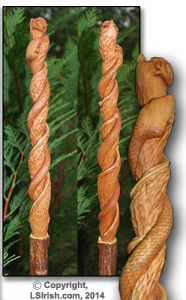 Twistie Snake Carving – Wood carving, cane and walking stick carving
Twistie Snake Carving – Wood carving, cane and walking stick carving
Not all of us are blessed to have a backyard wood lot where we can cultivate sassafras trees and honeysuckle vines for twistie stick canes. So in this in-depth tutorial learn how to carve that twisted stick pattern using a bench knife, a few small gouges, and basswood.
Pyrography Doodles – Pyrography and wood burning
If you have the burning desire to try your hand at the zen doodle craze or modern tribal tattoo look, you will want to read through this step-by-step wood burning project that uses textures, line designs, and fill patterns to create the finished mushroom design.
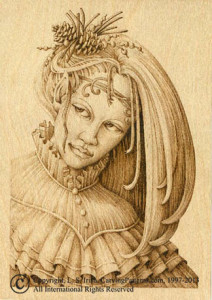 Pyrography Steps to Portrait Burning – Wood burning and pyrography
Pyrography Steps to Portrait Burning – Wood burning and pyrography
Learn how to create realistic shadows and highlights in the human face in your next wood burning project.
Cougar Pyrography Project – Wood burning and pyrography
Learn how to create the fine fur in an animal portrait that incorporates realistic shading and shape to the animal’s face.
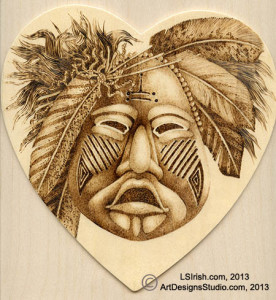 Ceremonial Mask Pyrography – Pyrography and wood burning
Ceremonial Mask Pyrography – Pyrography and wood burning
This step-by-step project uses lots and lots of photos to guide you through an in-depth design created for first-time wood burners.
Pyrography Leather Burning – Leather burning and leather pyrography
Want to try your hand at leather burning? Then this tutorial is just what you are looking for. Includes not only the step-by-step photo instructions but also includes the binding steps for making your own leather artist journal.
Posted on Other Message Boards or Forums
Please note that the following free L S Irish seminars and in-depth projects were posted by me, before we opened LSIrish.com, and are hosted on another forum. I am not responsible for this forum nor a member of this forum at this time.
Please note that you will need to sign-up as a member of this forum to have access to the photos included in each of the tutorials.
If you have questions about these projects please contact me directly, here at LSIrish.com or on my Facebook account, as I can not reply to you on this forum. If you do reply of any of these free tutorial, it will bring these threads to the front of the message board where other members may answer you.
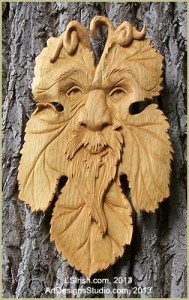 Relief Carving Wood Spirit Grape Man WIP – Over 250 detailed, close-up photos with step-by-step instructions of relief carving the wood spirit, green man face. This thread has had over 69,000 views!
Relief Carving Wood Spirit Grape Man WIP – Over 250 detailed, close-up photos with step-by-step instructions of relief carving the wood spirit, green man face. This thread has had over 69,000 views!
Levels in Relief – Learn how to break you carving pattern into levels for easy carving. This project will teach you how to identify the sky, background, mid-ground, and foreground of any design.
Burning your carvings – Pyrography can be an important technique for your wood carving. So learn how to use your wood burner to clean-up fine wood fibers, add detailing, and even add fine shaping to your next wood carving project.
African Mask Low Relief Carving – The African Mask project focuses on how to establish the levels of a relief wood carving during the rough-out stage of work.
Irish Pyrography Seminar – This in-depth pyrography project shows over 250 detailed, close-up photos, step-by-step instructions, and in-depth explanations of texturing, shadings, and fine line work used to create the Advertising Barn landscape.
Walnut Hollow Versa-Tool – Looking for that first wood burning tool, then take a few moments and read through this tutorial for an in-depth review of the Walnut Hollow Versa-Tool used to wood burn a Toucan Family.
Winter Birdhouse Wood Burning Tutorial – This in-depth, step-by-step project focuses on a winter bird house wood burning scene. The project takes you from the initial tracing of the design to the final coloring steps.
